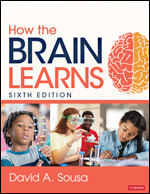How the Brain Learns
- David A. Sousa - International Educational Consultant
Deliver game-changing—and brain-changing—results for your students
Research on the brain continues to evolve, providing fresh insights educators can use to guide students toward success. In the sixth edition of this international bestseller, world-renowned educational neuroscience consultant David Sousa once again translates that research into concrete actions and strategies for the classroom.
Featuring important updates and brand-new findings, the latest edition includes:
- A new section on the expansion of SEL to SECL, integrating the cognitive component of social-emotional learning
- Additional research on mindsets—including cautions
- Effective, brain-compatible ways to safely use social media and online learning
- New information on the importance of student engagement, especially through academic teams
- Connections between Bloom’s Taxonomy and current instructional strategies, such as teaming and project/maker learning
Free resources
Practitioner's Corner: Avoid Teaching Concepts That Are Very Similar to Improve Transfer
In this "Practitioner's Corner" from How the Brain Learns, 6th Edition, you'll learn how teaching concepts that are similar can hinder, rather than help, transfer learning. Plus, author David A. Sousa offers his solutions.
Practitioner's Corner: Strategies for Using Movement
In this "Practitioner's Corner" from How the Brain Learns, 6th Edition, you'll learn several key strategies for incorporating movement into your lessons for students of all ages, improving engagement and helping them retain the lessons learned.
I have used the previous additions of this text. I find it very practical and my learners appreciate the simplicity of the way content is presented.
This is a complete edition with helpful / updated information to apply.
Revision plan includes the following changes and updates:
- Expand on the growth of educational neuroscience
- Introduce notion of teachers as 'brain-changers'
- Add more on mirror neurons
- Add a new section on social-emotional learning (SEL)
- Address notion of expanding SEL to SECL so that the cognitive component of learning is integrated
- Revise "windows of opportunity" section
- Expand section on mindset to include cautions in using it
- Add new videos
- Include effective brain-compatible ways to use the Internet and on-line learning, and how to avoid the serious perils that they can present
- Add a section on the importance of student engagement, especially through the use of academic teams (with accompanying research results)
- Revise chapter on transfer
- Connect Bloom's Taxonomy more closely with current instructional strategies such as teaming, flipped classrooms, project/maker learning, etc.

